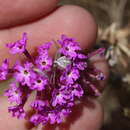Description
provided by eFloras
Plants annual. Stems decumbent to ascending, little to moderately branched, elongate, glandular-pubescent. Leaves: petiole 0.8-4 cm; blade ovate to oblong-ovate, 2-5 × 1.5-3.5 cm, margins entire to ± sinuate and undulate, surfaces glandular-pubescent. Inflorescences: peduncle longer than subtending petiole; bracts lanceolate to broadly ovate, 4-9 × 1.8-6 mm, papery, puberulent to glandular-pubescent, often villous basally; flowers 12-24. Perianth: tube rose red, at least basally, 10-20 mm, limb white to pink, 6-8 mm diam. Fruits winged, broadly cordate or ± round in profile, 4-6 × 4-6 mm, coriaceous, apex deeply notched with small beak; wings 2(-3), infrequently partially folded together, without dilations, interior spongy.
- license
- cc-by-nc-sa-3.0
- copyright
- Missouri Botanical Garden, 4344 Shaw Boulevard, St. Louis, MO, 63110 USA
Habitat
provided by eFloras
Sandy soils, Joshua tree desert scrub; 100-1600m.
- license
- cc-by-nc-sa-3.0
- copyright
- Missouri Botanical Garden, 4344 Shaw Boulevard, St. Louis, MO, 63110 USA
Comprehensive Description
provided by North American Flora
Abronia pogonantha Heimerl, Bot. Jahrb. 11: 87. 1889
Abronia angulata M. E. Jones, Contr. West. Bot. 8: 39. 1898.
Annual, much branched, the branches stout, ascending or decumbent, villous with long slender hairs and viscid-puberulent, often tinged with red; petioles 1-3.5 cm. long; leaf-blades ovate-oblong or broadly ovate, rarely orbicular-ovate or ovate-deltoid, 2.5-4.5 cm. long, 1-2 or rarely 3 cm. wide, rounded or rarely cordate at the base, rounded or very obtuse at the apex, entire, glandular-puberulent or glabrate on the upper surface, viscid-villous along the veins beneath and on the margins, at least when young; peduncles slender, 2-7 cm. long, viscid-villous and glandular-puberulent; bracts broadly ovate or rounded-ovate, 7-10 mm. long, acute or attenuate, scarious, viscid-villous outside, perianth about 2 cm. long, white or pink, the tube puberulent or glabrate above, usually densely long-villous below, the limb 6-8 mm. broad; fruit orbicular-ob cordate, 3-6 mm. long, compressed, 2-winged, rounded or obtuse at the base, the body finely reticulateveined, the wings thin, obscurely veined, minutely ciliolate; seed obovate, 2 mm. long, compressed, dark-brown, lustrous.
Type locality : Sandy banks of the Mohave River, California. Distribution: In san,dy soil, Inyo County to Los Angeles County, California.
- bibliographic citation
- Paul Carpenter Standley. 1918. (CHENOPODIALES); ALLIONIACEAE. North American flora. vol 21(3). New York Botanical Garden, New York, NY
Abronia pogonantha: Brief Summary
provided by wikipedia EN
Abronia pogonantha is a species of flowering plant in the four o'clock family (Nyctaginaceae) known by the common name Mojave sand-verbena. It is native to California and Nevada, where it grows in the Mojave Desert, adjacent hills and mountains, and parts of the San Joaquin Valley in the Central Valley.
This is an annual herb producing prostrate or upright glandular stems to about half a meter long. The petioled leaves are mainly oval-shaped and up to 5 centimeters long by 3 wide. The plant blooms in an inflorescence of many white or pink flowers, each with a tube throat up to 2 centimeters long. The fruit is a winged, heart-shaped body about half a centimeter long.
- license
- cc-by-sa-3.0
- copyright
- Wikipedia authors and editors

